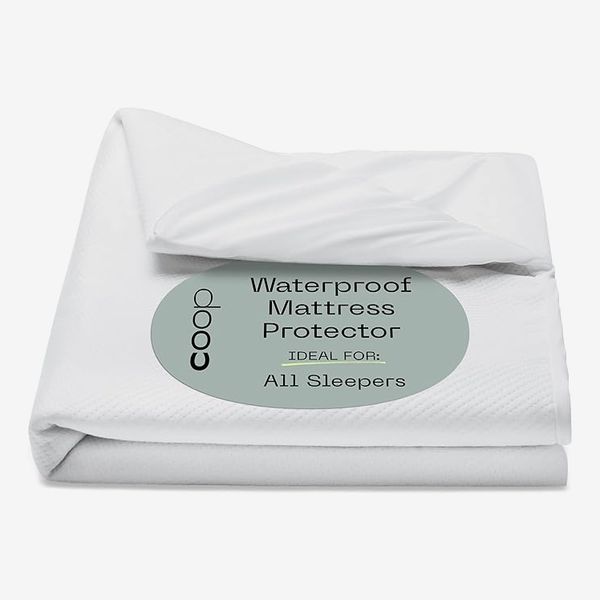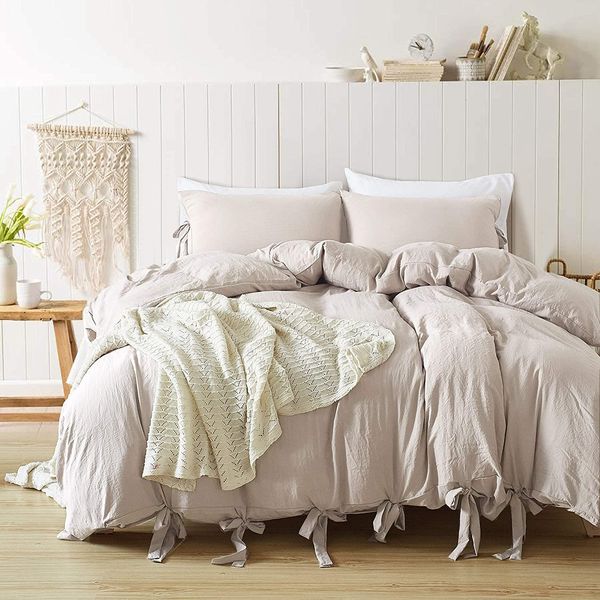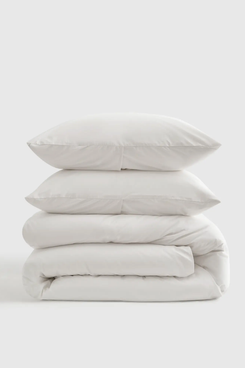
I spend a lot of time reviewing sleep gear, slightly in a vacuum: Here’s the best pillow; here’s the best mattress. And the trickiest part is the cost of it all, because sometimes there’s an annoyingly big gap in price — or a surprisingly small one! — between the very best and the totally good enough. If you’re starting from scratch and putting together an entire bed setup, just buying the best of everything gets very expensive, very quickly. Which got me thinking: What’s the minimum someone has to spend to get the best bed possible for the least amount of money?
Sure, anyone could buy a basic foam mattress for $300, a metal platform bed frame, and a selection of inexpensive bedding from Amazon, Target, or Walmart and call it a day. And there’s nothing wrong with that! But if you want a step up in quality, the products below are the ones I’d recommend starting with to get all the essentials without spending more than you need to. While I naturally had to choose a few items for this list that are less expensive than our “best overall” picks, everything here is of a high-enough quality that I wholeheartedly recommend it. At full list price, the full slate will run you about $1,500 — but I’ve also included a few ideas for where you can save extra or splurge more.
The mattress
Trust me — while it may be tempting to skimp here, you’ll appreciate a supportive mattress in the long run over fancy bedding or a design-y bed frame. This hybrid mattress from Zinus is listed at $999 full price, which isn’t a wildly low number but is considerably cheaper than many other mattresses we’ve reviewed. Plus it is very frequently on sale for around $699, so if you can hold out for a good deal (I recommend keeping an eye on our running list of mattress sales), you can free up some cash for fun extras like a weighted stuffed animal or a body pillow.
I named this mattress our best (less expensive) mattress overall because it’s a great mattress that’s also about $1,100 cheaper than our top pick, the Saatva Classic. I’ve continued sleeping on this mattress at home since originally reviewing it and appreciate how it’s supportive without being too firm; I can comfortably rotate between my side and back. I purposefully chose a hybrid mattress for this challenge, because even though I am a fan of all-foam mattresses made of memory foam — I’m a sucker for their sink-y, contouring feel — hybrids are a better bet if you are on a tight budget. Not only do hybrids generally provide sturdier base support thanks to the coils, but there’s less risk that you’ll end up with a mattress that disappoints you after a few months. In my experience, foam is a very get-what-you-pay-for material, and cheap all-foam mattresses tend to be lower quality, overall, than cheap hybrid mattresses. The mix of foam and coils together will likely be more comfortable in the long run.
The bed frame
The floor is not where your mattress belongs. Strategist home writer Lauren Ro has unearthed plenty of affordable bed frame picks, but this one from KD Frames is especially inexpensive, at just over $200. While it is quite simple, it looks a lot nicer than many other cheap bed frame options — there are some very creaky metal platform beds out there. The minimalist, solid-wood frame will pleasingly float your mattress about ten inches off the ground, and the brand says it can support up to 600 pounds. Because of the slats, you won’t need a box spring or anything extra to support your mattress, so it’s very much a one-and-done. And as a bonus, it folds in half in the event that you need to move or store it.
The pillows
It’s shockingly easy to spend upward of $150 on a pillow these days (my own favorite pillow, the Purple Harmony, costs $179). And while I do think it’s another product you should try not to skimp on — just like your mattress supports and cushions your body, your pillow supports and cushions your head and neck — there are a few cheaper pillows that I consider good go-tos.
This down-alternative pillow from Beckham Hotel Collection has been a long-time Strategist favorite, thanks to its affordability, comfort, and effective neck support. It’s a simple pillow, filled with polyester fiber fill, but it’s stuffed densely enough that it feels nice and cushy and won’t immediately go flat. It also works well with a lot of different sleep positions — Strategist staffers who are side sleepers, back sleepers, stomach sleepers, or a combo have all rested comfortably on it. Plus, it’s just $60 for a two-pack.
If you prefer denser memory foam over a fluffy fiber-filled pillow, however, I’d recommend the Weekender Gel Memory Foam pillow, our best (less expensive) overall memory-foam pillow. While the Beckham Hotel pillows offer good support for a down-alternative, the Weekender’s foam will give you a less obviously squishy feel and more heavy-duty neck support. It’s a single slab of foam, infused with gel and perforated for cooling. At first it feels slightly firm, but the longer I laid on it, the more my head and neck sank in for some pleasant cushioning. While the Beckham Hotel pillow is good for all three sleeping positions, I’d primarily recommend this one to back sleepers and side sleepers — I think it’s a bit too firm and lofty for comfortable stomach sleeping. This pillow is similarly priced to the Beckham Hotel ones, at $30 each.
The sheets
You’ll need at least one set of sheets (although ideally, get two to make laundry day less of a pain), and these ones from Quince happen to be our favorite sheets overall because they hit the sweet spot of being high quality while feeling more expensive than they are. They’re made of light and crisp cotton percale; Ro describes them as smooth to the touch, with a nice-looking matte finish, and so airy they almost feel paperlike. At $80 for a queen set, it’s hard to do much better. And while it’s true that you can certainly go cheaper on sheets, I like these because they’re good for hot sleepers (percale is super breathable), they’re made from organic cotton, and, according to Ro, they’re quite durable. I’m also willing to splurge a little more on sheets than some other bedding elements, since you’ll feel your sheets more close against your skin, than say, your duvet. These also come in 13 colors and patterns, primarily neutrals and earth tones, so they’ll be easy to work into existing décor.
For an even cheaper option, these cotton sateen sheets also come highly recommended by Ro — she says they feel surprisingly substantial, given the price. New York deputy editor Alexis Swerdloff is also a fan and has been impressed with how the sheets get softer with every wash. At just $50 for 100 percent cotton sheets — that come in a nice variety of color options — these are a true steal even at full price (but they occasionally go on sale for even less).
The mattress protector
You should never forgo a mattress protector — washing one is so, so much easier than trying to clean a mattress. Even if you don’t have pets or kids who are prone to spills or other accidents, a mattress protector can help keep your mattress free of dust, dead skin, sweat, even bedbugs if you buy the right kind. Mattress protectors are another product category that can get weirdly expensive, but my main qualifications for a good one are being truly waterproof and not making loud, plasticky sounds when you move around on them.
Our best-in-class pick from SafeRest will set you back a maximum of $70, which is the official list price, but I’ve actually never seen it cost that much. It has a layer of cotton terrycloth over the waterproof polyurethane, which gives it a soft and cozy feel and no plasticky crackling.
Or, if you run warmer, a second option is Coop’s waterproof mattress protector, which has cooling bamboo rayon over its waterproof layer. Bamboo rayon is known for regulating temperature and wicking moisture, so it’s a good pick for use in the summer. It’s about $60 at full price, but sometimes on sale.
The comforter
I’ve kept it pretty cheap here, since comforters and duvets get very pricey (case in point: our favorite “less expensive” down comforter, from Brooklinen, costs almost $400). So unless you’re willing to splash out for real down or other higher-end materials, I’d go with this down-alternative option from Linenspa, which is also one of Ro’s picks. It has a microfiber shell and is filled with polyester fiber fill, so it is conveniently machine-washable. The weight should work for all seasons, and if you want to add a duvet cover in the future, you can use the comforter as an insert, since it has corner loops to attach a duvet cover. But if you use it without a cover, it does come in a few different colors, including white, black, gray, and a few brown shades. (Though, because it is a lighter comforter overall, if you live in a region that gets very cold, you may need to supplement with an additional quilt or blanket in the winter.)
The (optional) duvet cover
A duvet cover isn’t an absolute must-have, but can help keep your comforter or duvet clean while adding some aesthetic flair.
This microfiber one with decorative ties is one of the most affordable options we’ve found. It earned a spot on Ro’s list of best duvet covers after a home-design expert recommended for its casual, bohemian feel.
Another reasonably affordable duvet — and a high-value option for the price, especially if you want your sheets and duvet cover to match — is this one from Quince that costs just about $100 for a queen size, and comes in the same 13 colors and patterns as the brand’s percale sheets that I recommended above.
At full price, that’s all the essentials for about $1,500
If you buy everything here at the full list price — which actually may not be super likely, given that lots of these products frequently go on sale — you’re looking at $999 for the queen-size Zinus Ultra Cooling Green Tea Hybrid mattress, $209 for the queen-size KD Frames Platform Bed, $60 for a pair of pillows, $80 for the queen-size Quince sheets (or $50 for the Target ones), $60 to $70 for a mattress protector, and $30 for the Linenspa comforter. Then, if you add the $40 Annadaif duvet cover or the $90 Quince one, your total will be either just under $1,500 or just over, before sales or taxes.
If you only upgrade one thing
If you find some deals on all the items above or you’re simply willing to spend a little more, I’d recommend splurging on a pillow upgrade.
We’ve reviewed lots of great pillows, but the Purple Harmony is my personal favorite. It’s definitely an expensive one, but I think it’s worth the price. It has a core made of latex, which is a type of foam that’s bouncy, responsive, and cooling, so I generally prefer it over memory foam. On top of the latex, there’s a thin layer of Purple’s GelFlex grid sewn into the pillow’s cover, which makes the pillow feel even more cool and bouncy than similar latex pillows. I love this in a pillow because it provides really sturdy support, without feeling overly stiff or firm — the latex is flexible and pliant. It also comes in three lofts, so you can choose the height that works best for your typical sleeping position.
The Strategist is designed to surface useful, expert recommendations for things to buy across the vast e-commerce landscape. Every product is independently selected by our team of editors, whom you can read about here. We update links when possible, but note that deals can expire and all prices are subject to change.


















